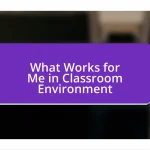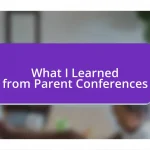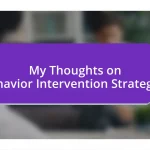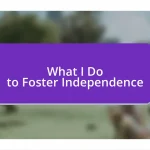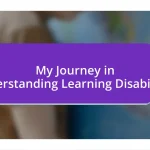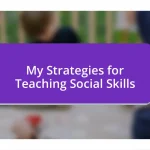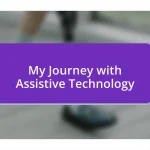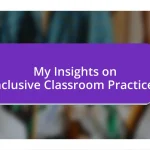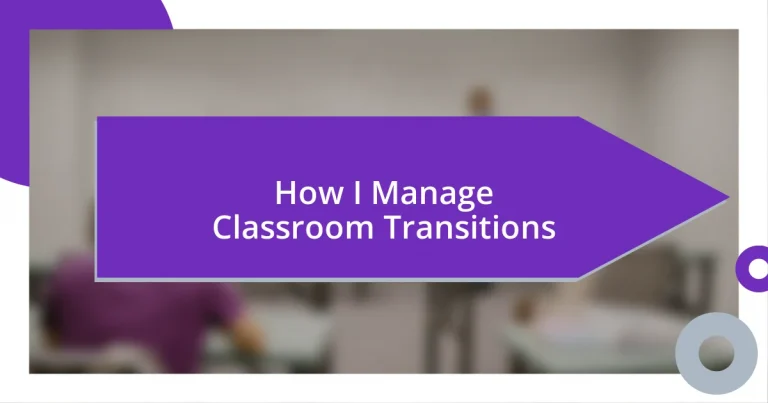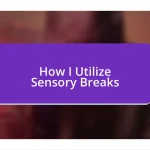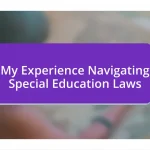Key takeaways:
- Effective classroom transitions require emotional intelligence and engagement strategies, such as mindfulness exercises and clear communication.
- Incorporating music, visual aids, and student input can transform the transition experience, fostering a positive and excited classroom atmosphere.
- Evaluating transitions through student feedback helps tailor practices to meet diverse learning needs, ensuring a supportive and inclusive environment.
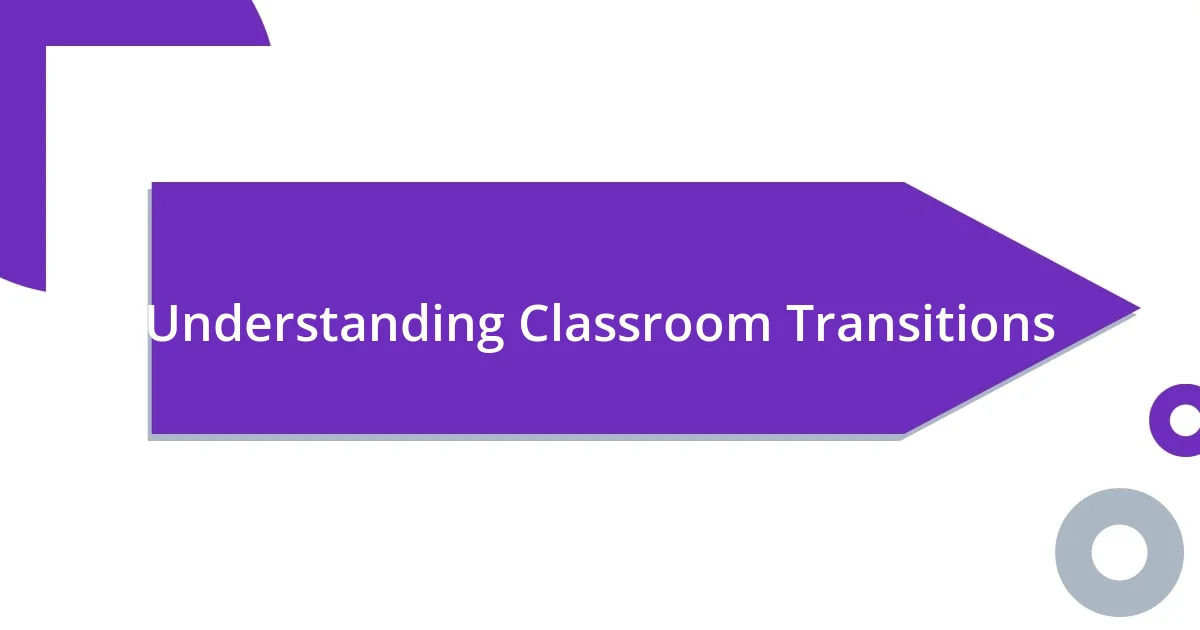
Understanding Classroom Transitions
Classroom transitions are those pivotal moments when students shift from one activity to another. I remember a time when my class was transitioning from a lively group discussion to a quiet writing session. The energy in the room was palpable, and I had to quickly gauge whether the students needed a moment to refocus or were ready to dive into their writing. This nuanced understanding is key; it’s not just about the schedule; it’s about the rhythm of the classroom and how the students are feeling in that moment.
I often find myself reflecting on how successful transitions rely on more than just logistics. They require a certain emotional intelligence. Have you ever noticed the difference between a smooth transition and one that feels like pulling teeth? When I actively engage students with a short mindfulness exercise before switching tasks, I see them responding positively. It’s as if I’m helping them bridge the gap between activities, allowing them to carry over the focus instead of losing it completely.
Understanding these transitions means recognizing their impact on both learning and behavior. Students can become restless or lose interest if they’re not properly guided from one task to another. By paying close attention to their body language and taking a moment to listen to their needs, I find I can facilitate a more effective transition. Each shift in the classroom offers an opportunity to foster a supportive environment, making it essential to prioritize this aspect of teaching.
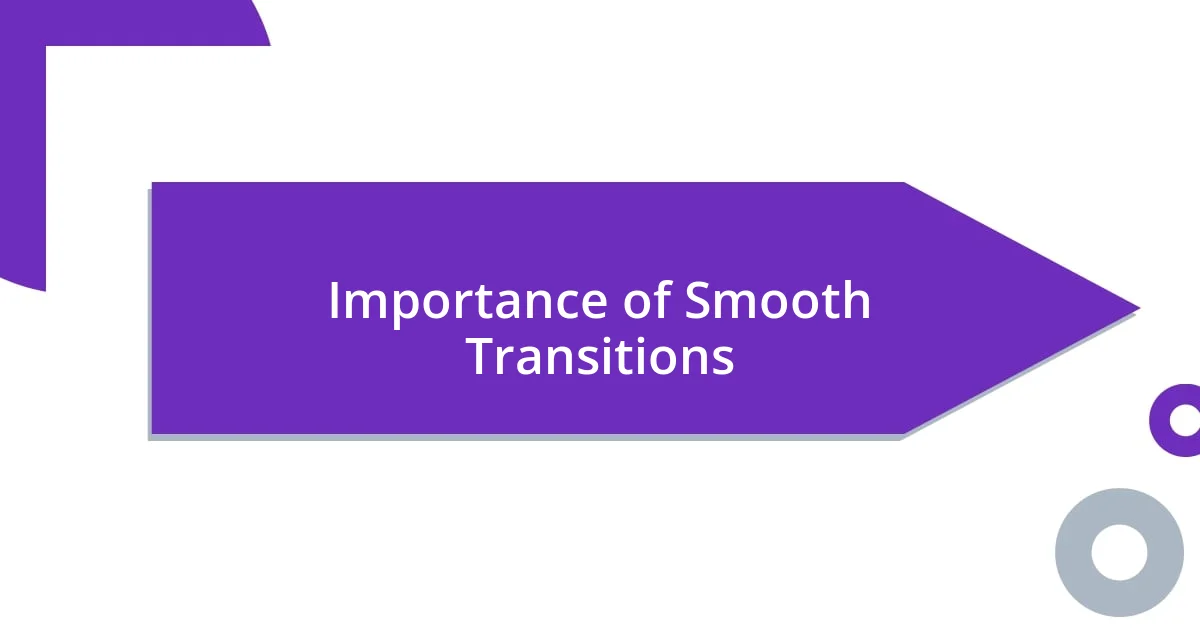
Importance of Smooth Transitions
Smooth transitions in the classroom are fundamentally important because they help maintain a conducive learning environment. For instance, I often use musical cues as a signal to wrap up an activity, and it’s fascinating how students respond to specific melodies. That simple act of integrating music not only prompts them to shift gears but also infuses a sense of fun into the process, making it feel less abrupt.
When transitions are not seamless, I notice a significant increase in chatter and distraction. Last week, I experienced a hiccup transitioning from a science experiment to a writing assignment. The energy shifted; students were still buzzing about their findings instead of focusing on the task at hand. This taught me that without a clear and engaging roadmap for the transition, I risk losing their attention, which can derail our learning objectives.
Moreover, the emotional climate of the classroom can hinge on how we handle these moments. I find that incorporating a short breathing exercise as we shift from one activity to another not only calms the students but also sets a positive tone for their next task. It’s in these small practices that I see a change not just in behavior, but in the overall classroom atmosphere—the ripple effect can’t be overstated.
| Aspect | Impact of Smooth Transitions |
|---|---|
| Focus | Maintains student attention and readiness to learn. |
| Energy Level | Helps regulate the classroom energy, preventing chaos. |
| Emotional Well-being | Supports students’ emotional state, allowing for better engagement. |
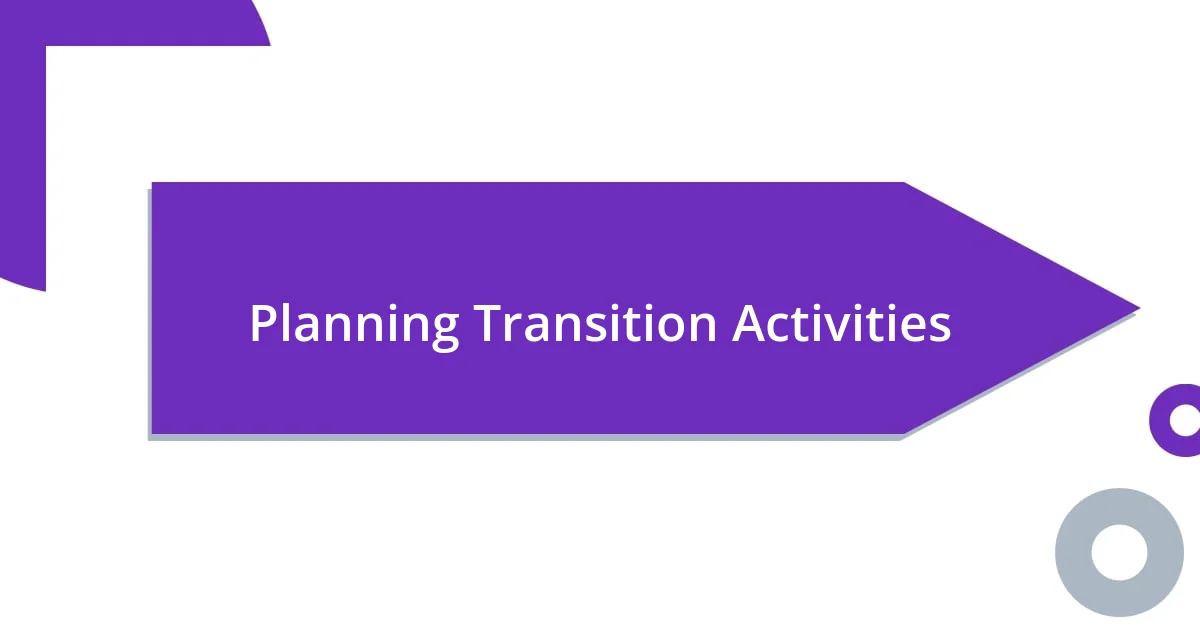
Planning Transition Activities
Planning effective transition activities is all about foresight and creativity. I’ve learned to weave activities into the fabric of each transition, so it feels seamless and intentional. One day, I noticed that transitioning from reading time to math required a more engaging approach. So, I introduced a quick “math riddle” challenge, which not only piqued their curiosity but also sparked competitive spirits. Seeing their faces light up while solving riddles made the shift feel like an exciting game rather than a mundane task.
When planning these activities, consider using diverse strategies to cater to different learning styles. Here are some ideas that have worked well in my classroom:
- Brain Break Exercises: Short, fun physical activities to re-energize students.
- Creative Visualization: Guiding students through a brief visualization to prepare them for the next task.
- Collaborative Group Challenges: Engaging students in brief group tasks that ignite teamwork.
- Storytelling Segments: Transitioning with a quick story related to the next subject matter can spark interest.
- Reflection Moments: Asking students to share one thing they learned from the previous activity prepares their minds for new information.
These strategies keep engagement high and encourage a positive mindset as students shift from one learning mode to another. In my experience, creating a sense of anticipation makes all the difference.
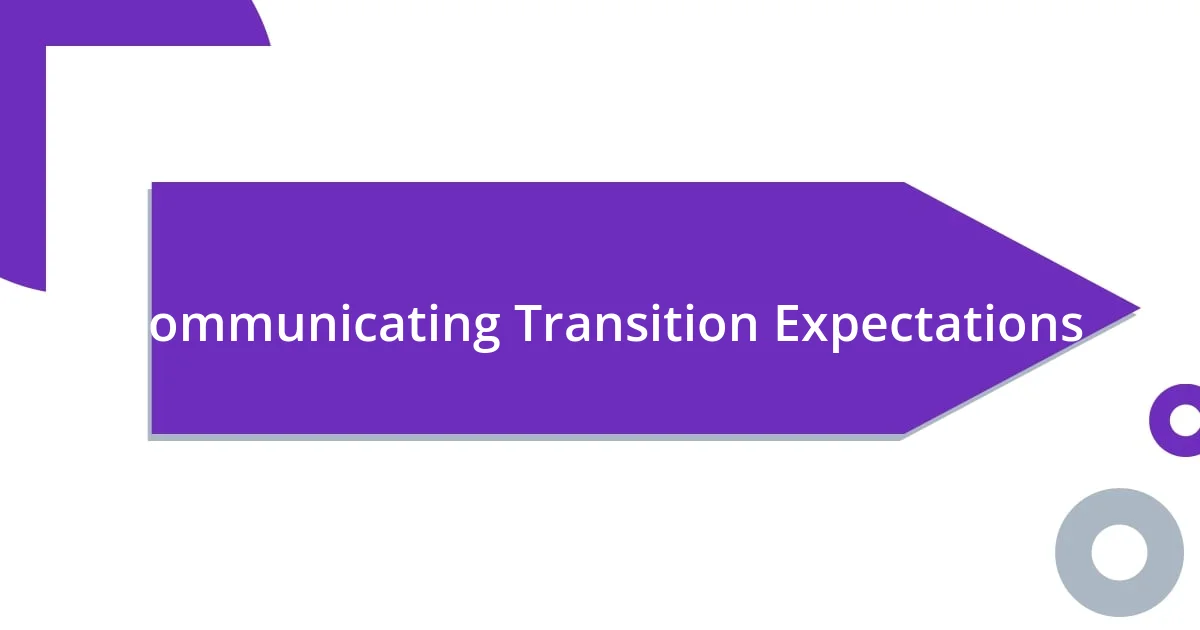
Communicating Transition Expectations
Communicating transition expectations is crucial for setting the tone of each activity in my classroom. I often find that simply stating what’s coming next can make a world of difference. When I tell my students, “In five minutes, we’ll switch from reading to a quick game related to our story,” I see their eyes light up. There’s something powerful about giving them a clear picture of what to expect; it fosters anticipation and readiness.
Sometimes, I use visual aids like charts or slides to outline our daily transitions. These tools serve as reminders and reduce anxiety. Just the other day, I displayed a colorful schedule that highlighted the transitions for the day, and I could feel a collective sigh of relief when I made it clear what was next. It’s like giving a road map to a trip; when students know the stops, the journey feels more controlled and exciting.
I also encourage my students to voice their thoughts about transitions. I often ask, “What do you think would help us move smoothly from our science project to writing today?” Their input is eye-opening. Recently, one student suggested a fun countdown while another proposed a quick tune to signal shifts. By incorporating their ideas, not only do I communicate expectations, but I also build a collaborative classroom culture. By embracing their suggestions, I find that students take ownership of the transition process and are more engaged in their learning. Isn’t it fascinating how communication can transform the energy in a classroom?
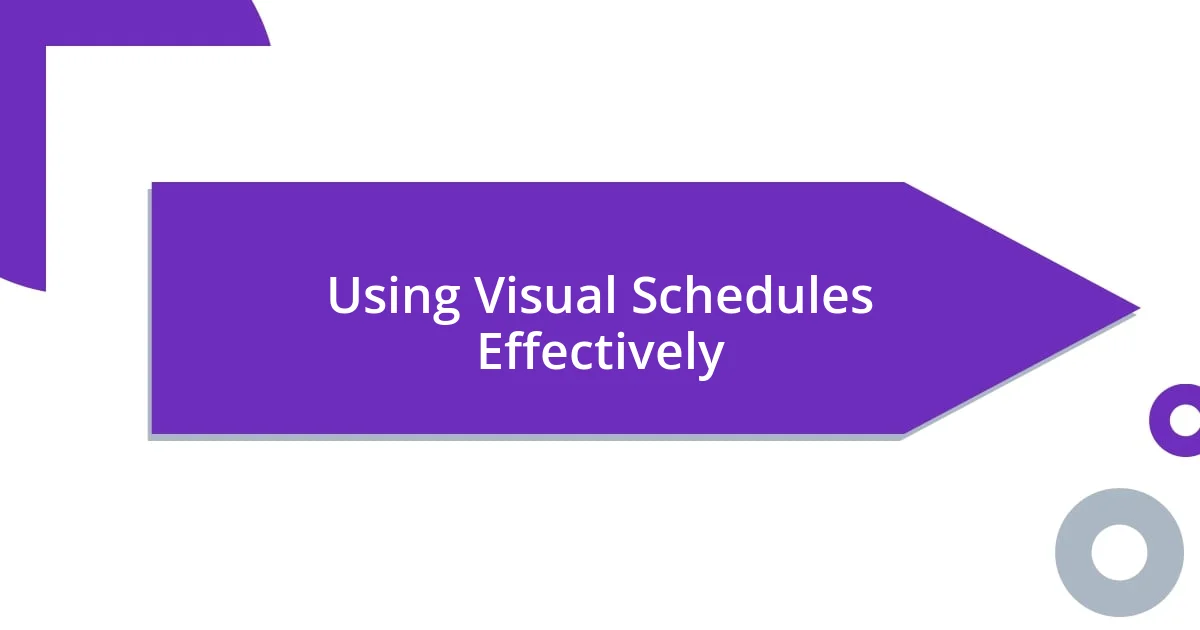
Using Visual Schedules Effectively
Using visual schedules effectively can truly transform the transition experience in the classroom. In my own practice, I’ve discovered that colorful visuals—like charts, images, or timelines—are not just decorative; they act as engaging tools that help students grasp what’s coming next. I recall a day when I introduced a bright, illustrated schedule. The moment they saw it, their chatter shifted from nervous fidgeting to eager discussions about what they were looking forward to, making me realize just how impactful visuals can be.
I’ve also found that it’s crucial to involve students in the process of creating these visual schedules. A memorable experience occurred when I asked my class to help design our weekly schedule. They chose their favorite colors and images that represented each subject. The excitement was palpable as they felt a sense of ownership over the tool they would use daily. I still remember one student, Jake, beaming with pride as he pointed out the picture of a rocket representing science—he loved space! It’s fascinating how a personal connection to a schedule can smooth transitions and cultivate enthusiasm.
Incorporating routine check-ins with the visual schedule forms another layer of effectiveness. For instance, at the end of the day, I often gather the students to reflect on how the schedule helped them transition. Asking, “What did you enjoy the most about our schedule today?” encourages them to think critically about their experiences. The replies tend to be enlightening; they often mention how certain visuals made them feel more prepared. It makes me wonder, have we underestimated the power of seeing our day laid out visually? In my journey, it’s evident that when students engage with their schedules, the energy in the room changes for the better.
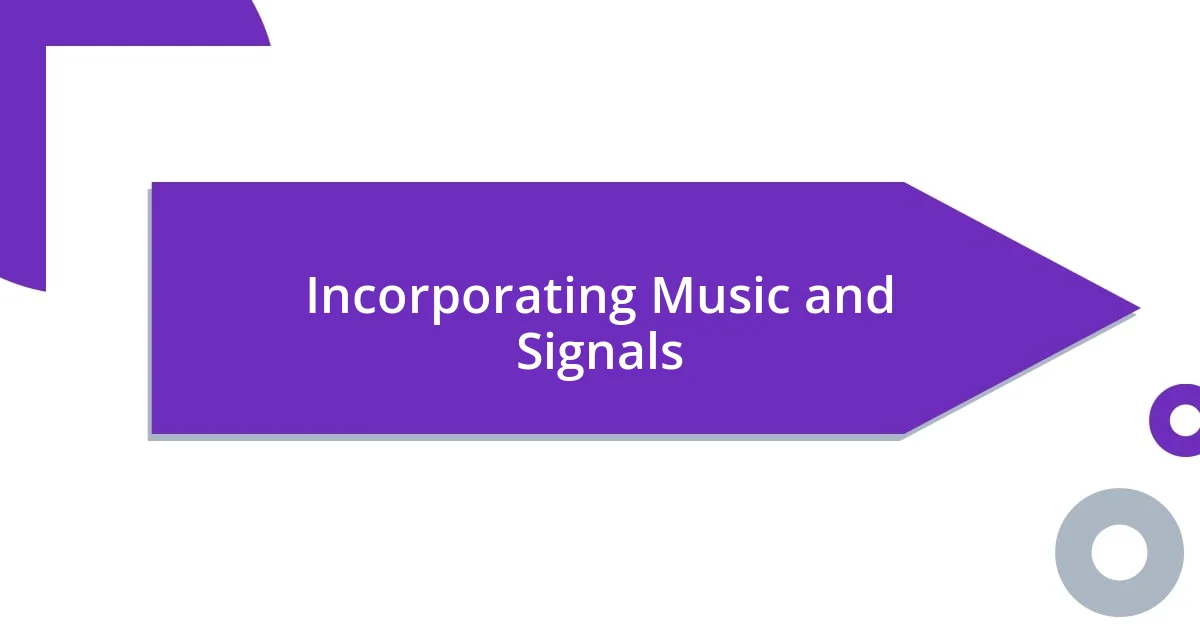
Incorporating Music and Signals
Incorporating music and signals into my classroom transitions has been a game-changer for keeping my students focused and energized. I remember the first time I played a short, upbeat song to signal the end of a quiet reading session. It was as if a switch flipped—students jumped up with excitement, ready to tackle the next activity. I often wonder, how can something as simple as music transform the mood in the classroom so dramatically?
I also use gentle hand signals to complement the music. When I raise my hand or make a specific gesture, it’s like a secret code that signals students to wrap up what they’re doing. One day, I noticed a group of my more tactile learners responded especially well; when I gestured for them to transition, they mimicked my movements, creating an engaging environment where they felt involved. It makes me think: how powerful can non-verbal communication be in guiding transitions?
The key is to keep my chosen tunes and signals consistent. I remember introducing a catchy jingle that indicated clean-up time; to my surprise, students would start singing it before I even cued them. By fostering this kind of atmosphere, transitions become a shared experience rather than a chore. I often reflect on how these musical and visual cues not only help with the flow but also create a joyful rhythm in our school day. Isn’t it wonderful how the right sound can not only capture attention but elevate collective spirit?
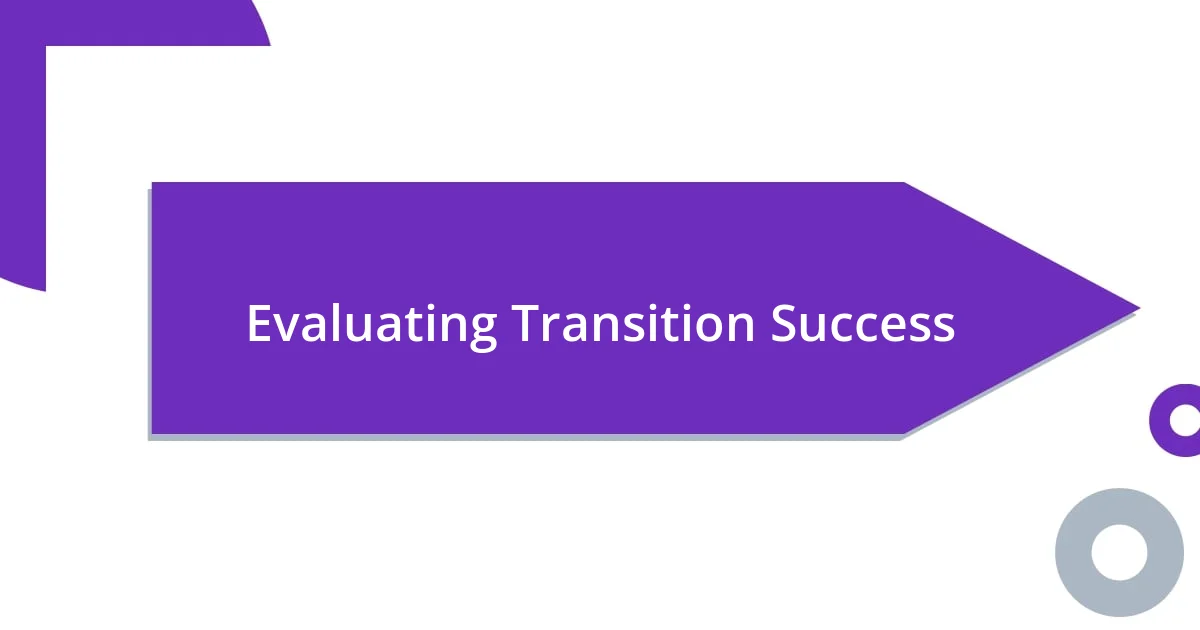
Evaluating Transition Success
I’ve learned that evaluating the success of transitions doesn’t just hinge on how smoothly we move from one activity to another; it’s about student engagement and emotional responses. One day, while observing a science experiment transition, I noted how some students stayed quietly excited, while others visibly struggled. That stark contrast made me question: are we really attuned to how our approaches resonate with each individual?
To dive deeper into this aspect, I began implementing quick informal surveys after transitions, asking students to share their thoughts about the process. It was enlightening to hear feedback, such as, “I liked how we moved quickly!” or “I felt a little lost.” Each response provided invaluable insights that helped me tailor future transitions to meet diverse needs better. I discovered that even a small tweak could transform a chaotic change into a harmonious flow.
One method I particularly enjoyed was holding an open discussion on what worked well and what didn’t. It was during one of these discussions that a shy student expressed how much she preferred transitions that blocked out distractions. Hearing her perspective made me realize the importance of creating a supportive environment where every voice counts. Evaluating transition success isn’t just about logistics; it’s about nurturing an inclusive space where each student’s experience is valued and heard.

